Belkin F5D6131 Wireless Access Point User Manual P73829 A F5D6130 man
Belkin International, Inc. Wireless Access Point P73829 A F5D6130 man
Belkin >
User manual
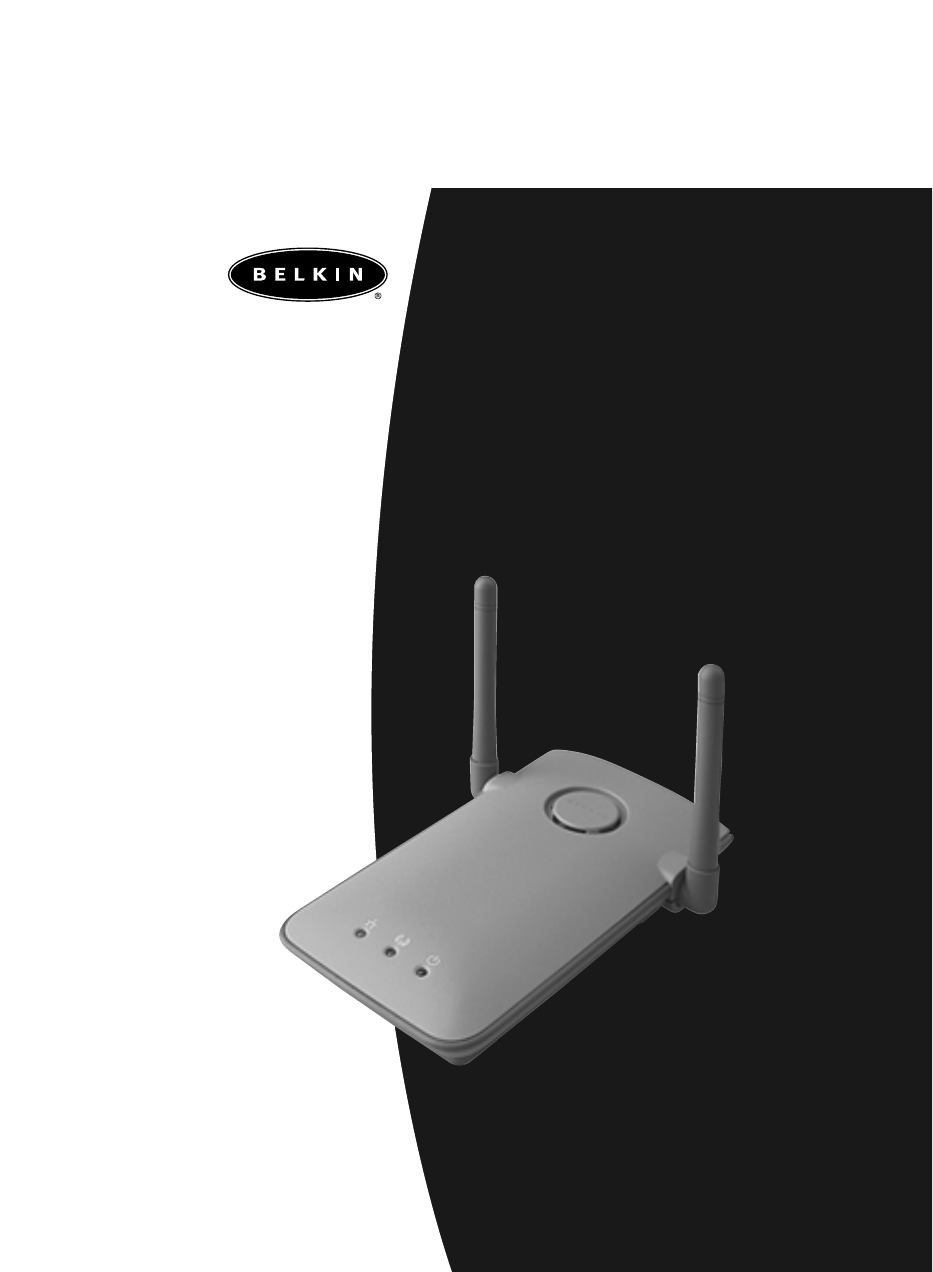
F5D6130
Wireless Network
Access Point
User Manual

Table of Contents
Introduction . . . . . . . . . . . . . . . . . . . . . . . . . . . . . . . . . . . . . . . . 1–2
Product Specifications . . . . . . . . . . . . . . . . . . . . . . . . . . . . . . . . . . 3
Knowing your Belkin Wireless Access Point . . . . . . . . . . . . . . . . . 4–5
Quick Setup . . . . . . . . . . . . . . . . . . . . . . . . . . . . . . . . . . . . . . . 6–7
Installation . . . . . . . . . . . . . . . . . . . . . . . . . . . . . . . . . . . . . . . . 8–10
Installing the Wireless Access Point Manager Software . . . . . . . 11–12
Using the Belkin Wireless Access Point Manager . . . . . . . . . . . 13–21
Wireless Networking Using 802.11b . . . . . . . . . . . . . . . . . . . . 22–25
Glossary of Wireless Networking Terms . . . . . . . . . . . . . . . . . . 26–27
Glossary of Wired Networking Terms . . . . . . . . . . . . . . . . . . . 28–29
Troubleshooting . . . . . . . . . . . . . . . . . . . . . . . . . . . . . . . . . . . . . . 30
Notes . . . . . . . . . . . . . . . . . . . . . . . . . . . . . . . . . . . . . . . . . . . . . 31
Information . . . . . . . . . . . . . . . . . . . . . . . . . . . . . . . . . . . . . . ..32-33

1
Introduction
Thank you for purchasing the Belkin 11Mbps Wireless Access Point (WAP)
and welcome to the world of wireless networking. Now you can take
advantage of this great new technology and gain the freedom you need
around the home or office without using cables. The WAP acts as a bridge
between your existing wired network and your wireless equipped
computers. The easy installation and setup will have you networking
wirelessly in minutes. Please be sure to read through this manual
completely to be sure that you are getting the most out of your WAP.
Key Features
Wide Area Coverage at High Speeds
The Belkin WAP provides coverage over an indoor area up to 300 feet in
radius and an outdoor area over 1,800 feet in radius.
Up to 128-bit Security Encryption
Your Belkin WAP is capable of encrypting (scrambling) the transmitted radio
waves so you can be sure that your data is secure. The optional encryption
feature allows you to encrypt at 64-bits or 128-bits using a key that you
enter yourself.
MAC Address Filtering
For added security, you can set up a list of MAC addresses (unique client
identifiers) that are allowed access to your wireless network. Every computer
equipped with a wireless network adapter has its own MAC address. Simply
enter these MAC addresses into a list using the Belkin Wireless 802.11b
Network Manager software, and access to your network through the WAP is
restricted to only those MAC addresses.

Introduction
2
Applications
•Wireless roaming with a laptop around the home or office
Gain the freedom you need around the home or office with no cables.
•Difficult-to-wire environments
For use in buildings with solid or finished walls or open areas where
wiring is difficult to employ.
• Frequently Changing Environments
Offices or environments that frequently rearrange the workplace and
change location.
•Temporary LANs for special projects or peak time
Trade shows, exhibitions, and construction sites that need a network on
a temporary basis. Companies that need additional workstations for a
peak activity period.
•SOHO (Small Office/Home Office)
SOHO users who need easy and quick setup.
Package Contents
• Belkin Wireless Network Access Point
• Power Supply
• Belkin 802.11b Wireless Manager Software
• User Manual
System Requirements
• At least one computer equipped with an 802.11b compliant wireless
Ethernet adapter
• TCP/IP networking protocol installed on each computer

Product Specifications
3
Specifications
Wireless Standard: 802.11b
Radio Technology: Direct Sequence Spread Spectrum (DSSS)
Operating Channels: IEEE 802.11 compliant
11 channels (US, Canada)
13 channels (ETSI)
14 channels (Japan)
Data Rate: 11, 5.5, 2, 1Mbps per channel (Auto-Rollback)
Typical Indoor
Operating Range: 590 ft.(180M) @ 11Mbps
984 ft.(300M) @ 5.5Mbps
1476 ft.(450M) @ 2Mbps
1800 ft.(550M) @ 1Mbps
Network Standards: IEEE 802.3 10BaseT
LED Indicator: Link, Activity, and Power
Frequency Band: ISM Band, 2400 ~ 2483.5MHz
Modulation Type: QPSK, BPSK, CCK
Data Rate: 1/2/5.5/11Mbps per channel
Protocol: CSMA/CA (Collision Avoidance) with ACK
Output Power: 13dBm ~ 20dBm (50 mW) (max.)
Receive Sensitivity: Min. -78dBm for 11Mbps @BER 10E-5;
Min. -82dBm for 5.5/2/1Mbps @BER 10E-5
Encryption: 64/128-bit WEP (Wired Equivalent Privacy)
Antenna Type: 2dBi (max.) @ External PCB patch diversity antenna
Power Consumption: 5V, 750mA max.
Physical Dimensions: 114.5 x 54 x 5.0mm
Weight: 50 g
OS Support: Windows®95 (OSR2), 98, 2000, NT,
Millennium Edition
Certification: FCC Class B, CE Mark, C-Tick
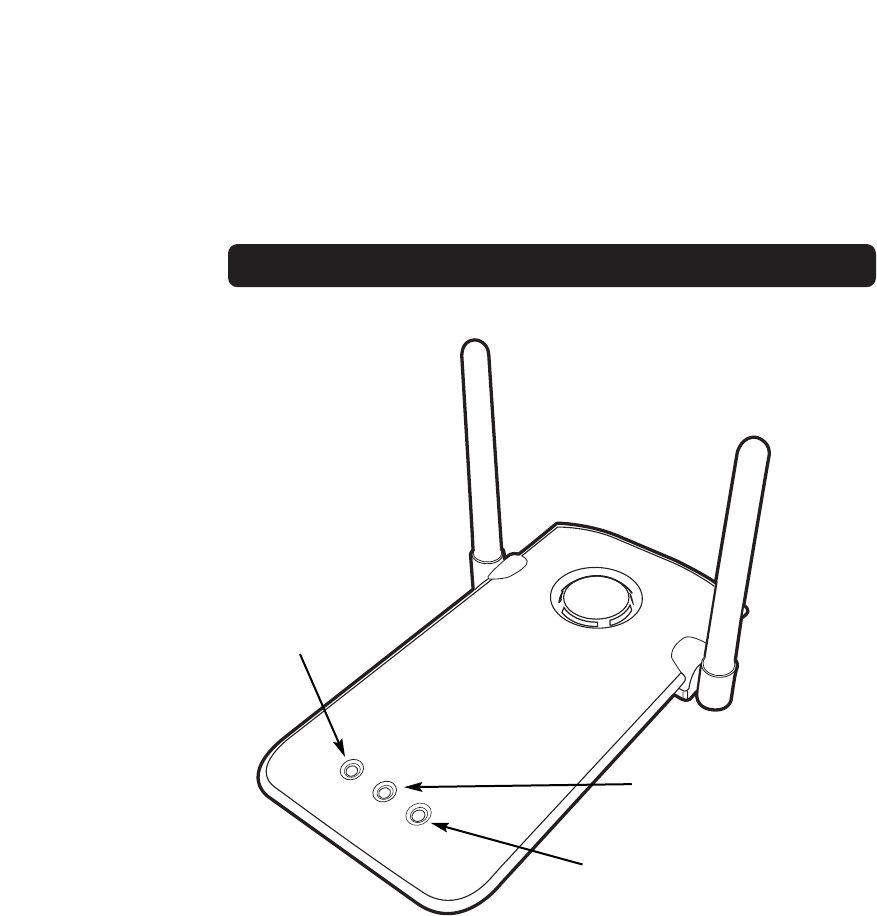
Knowing your Belkin Wireless Access Point
4
Power LED
Indicates that the WAP is receiving power
Transmit/Receive LED
Flashing Green: Indicates data is being transmitted
Flashing Amber: Indicates data is being received
Ethernet Link/Activity LED
Solid Green: Indicates a valid Ethernet (Wired) cable link
Flashing Orange: Indicates Ethernet (Wired) activity
Power LED
Ethernet
Link/Activity LED
Transmit/Receive LED
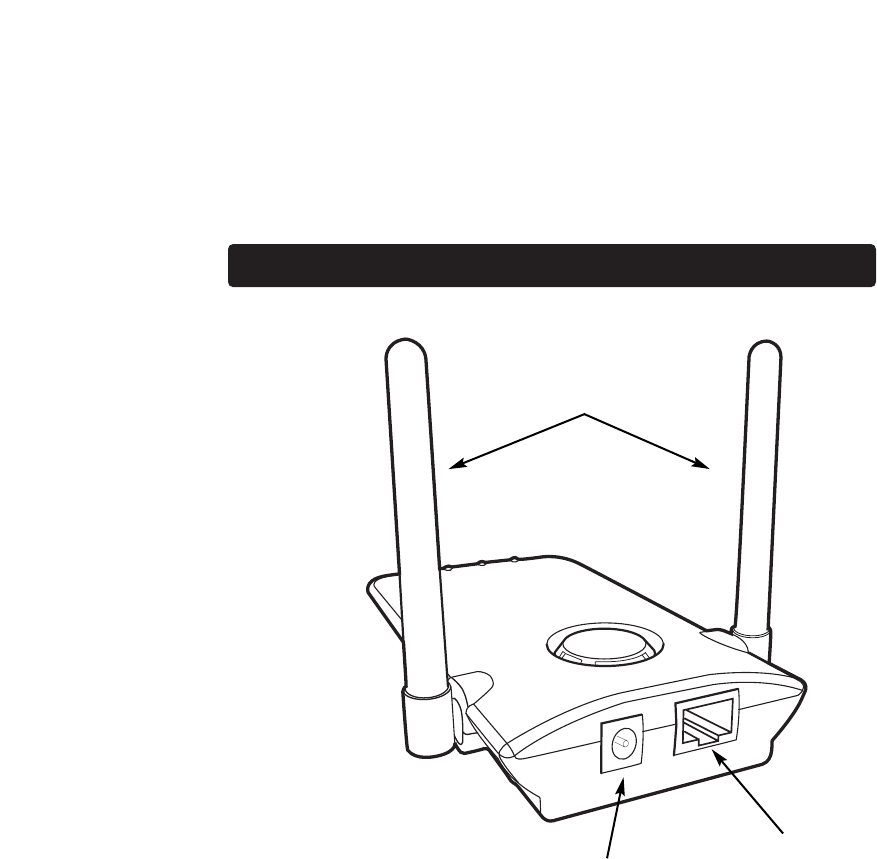
Knowing your Belkin Wireless Access Point
5
DC Power Jack
Connect the 9V DC connector from the power supply to this jack.
RJ45 Ethernet Jack
Connect an Ethernet cable to this socket, and connect to an open RJ45
10BaseT port on a switch or hub.
Rotatable Dual Dipole Antennas
Two unidirectional dipole antennas are located on the side of the WAP. The
antennas can rotate 360 degrees. The antennas should be oriented in the
vertical position for best operation.
Rotatable Dual
Dipole Antennas
DC Power Jack
RJ45 Ethernet
Jack
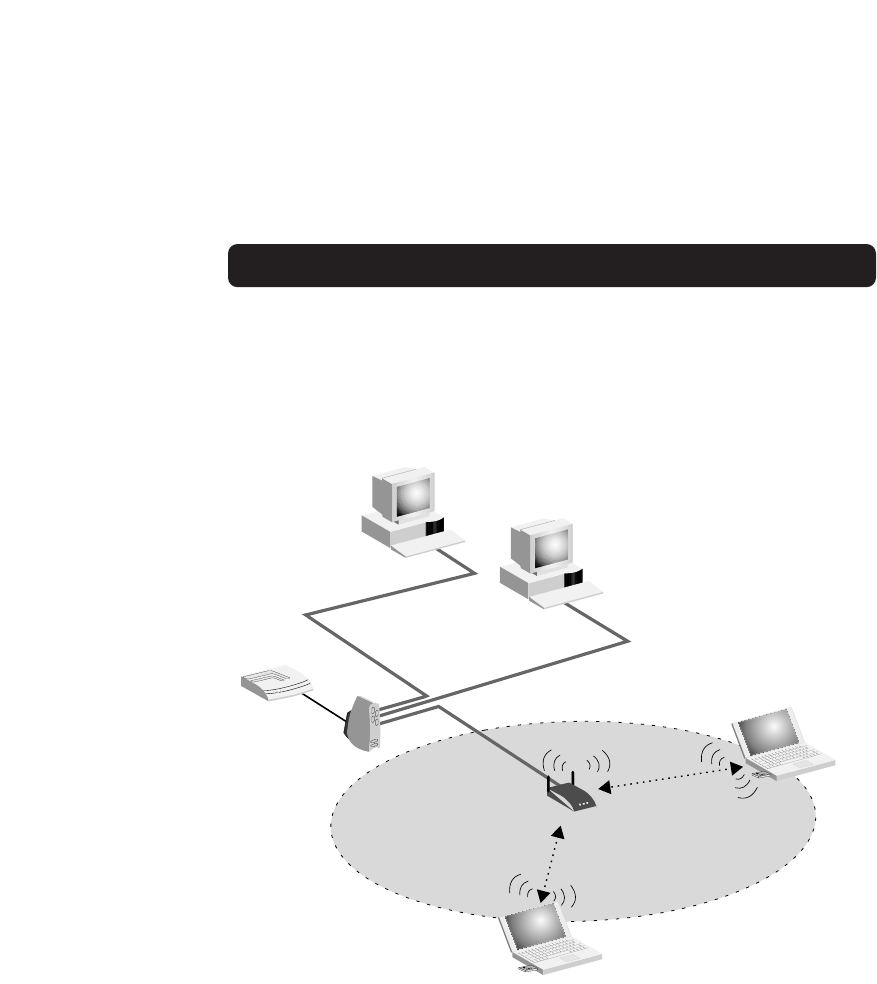
Quick Setup
6
Quick Setup—Connecting the WAP to your
existing network
The factory settings of the Belkin WAP were chosen to get you up and
running quickly.
Step 1: Installation Site Selection
In general, the best location to place the WAP is at the center of your wireless
coverage area, within line-of-sight of all wireless stations. Ensure all stations are
within the service range of the WAP.
Step 2: Hardware Setup
1.Connect your wired LAN to the WAP via a 10Mbps connection using a
Category 3 or Category 5 cable with a standard RJ45 connector (not a
Desktop PC
Desktop PC
Cable/DSL
Modem
Belkin Router
or Switch
Wireless
Access Point
Notebook with Wireless
Notebook Network Card
Notebook with Wireless
Notebook Network Card

Quick Setup
7
crossover cable). This connection from your wired LAN would come from
a hub or switch connected to your LAN or a cable/DSL router.
2.Connect the external power supply to the 5V DC socket on the rear panel
of the WAP.
Step 3: Install the Belkin WAP Manager Software
1.Insert the CD into the CD-ROM drive.
2.Access your CD-ROM drive by double-clicking on the CD-ROM icon in
the "My Computer" window. Double-click on the "Setup" icon and follow
the directions in the installation wizard.
Step 4: Configure the Wireless-Equipped Computer(s) to Communicate with
the WAP
1.Start up the wireless-equipped computer and configure the
wireless-equipped PC to connect to an SSID of "WLAN" or "Any".
2.If not done already, configure the wireless-equipped PC to "Obtain IP
Address Automatically".
3.Restart the wireless-equipped PC.
Your Belkin WAP is now fully configured. To configure advanced features,
please reference the Installation section.
Default Settings:
WAP Parameter Default Value
AP Name MiniAP
SSID WLAN
Channel 11
RTS Threshold 2346
IP Address 192.168.0.254
Subnet Mask 255.255.255.0
Default Gateway 0.0.0.0
DHCP Client Enabled
Encryption Disabled
MAC Address Filter Disabled
Password MiniAP (case-sensitive)

Installation
8
Selecting an appropriate site for your WAP
Selecting an appropriate site for your WAP will ensure the best
performance. First, a few rules of thumb:
• Avoid locating the WAP near metal objects such as appliances like
refrigerators, ovens, and washer/dryers. Keep in mind that your
appliances may be on the other side of the wall in the area that you
may be considering to locate the WAP.
• For best performance, locate the WAP as close to the center of the area
that you will be covering. Keep in mind that radio waves radiate
outward from the WAP in a circular pattern. Typical range is 100-150
feet indoors at 11Mbps. If the area you wish to cover is smaller than
200-300 feet wide, then locating the WAP in the center of the area
becomes less critical.
• Normally, the higher that you locate the WAP, the better the
performance and range will be. However, in an area such as an
average-sized house or small office, height is less critical.
• Remember that many things can cause a degrade of the radio signal
such as brick walls, metal-reinforced concrete, the metal housing of
appliances, or even wiring in the walls.
Connecting the WAP to a cable/DSL router, Ethernet
switch, or hub
1. Select a suitable site for your WAP.
2. Connect a CAT5 cable between the WAP and your cable/DSL
router’s LAN port, Ethernet switch, or hub by plugging one end of
the cable into the RJ45 jack on the WAP and the other end into an
open RJ45 jack on the cable/DSL router, Ethernet switch, or hub.
3. Connect the power supply to the WAP by plugging the round DC
connector into the DC jack on the WAP. Plug the power supply into
the wall. Verify that the Power LED and the Link LED are
illuminated. If both LEDs are illuminated, this indicates that the
WAP is connected properly.
4. Place the WAP on a desktop or mount it to a wall in the location
that you have chosen. Next, swivel the antennas so they are both
pointing up.
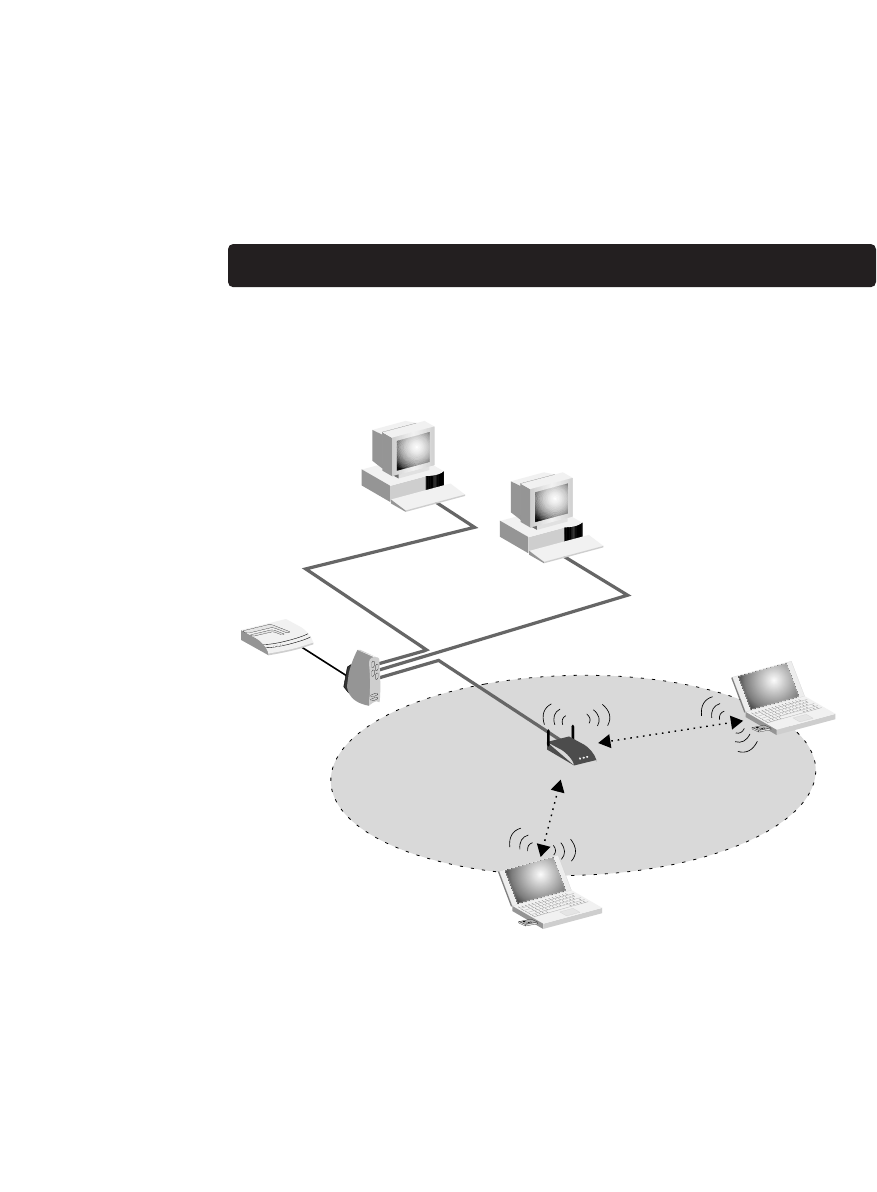
Installation
9
Connection and placement of your WAP is now complete. Go to
"Installing the WAP Manager Software" to learn how to configure
the WAP.
Fig. 1 Connecting the WAP to a cable/DSL router, Ethernet switch, or hub
Desktop PC
Desktop PC
Cable/DSL
Modem
Belkin Router
or Switch
Wireless
Access Point
Wireless Notebook
Network Card
Wireless Notebook
Network Card
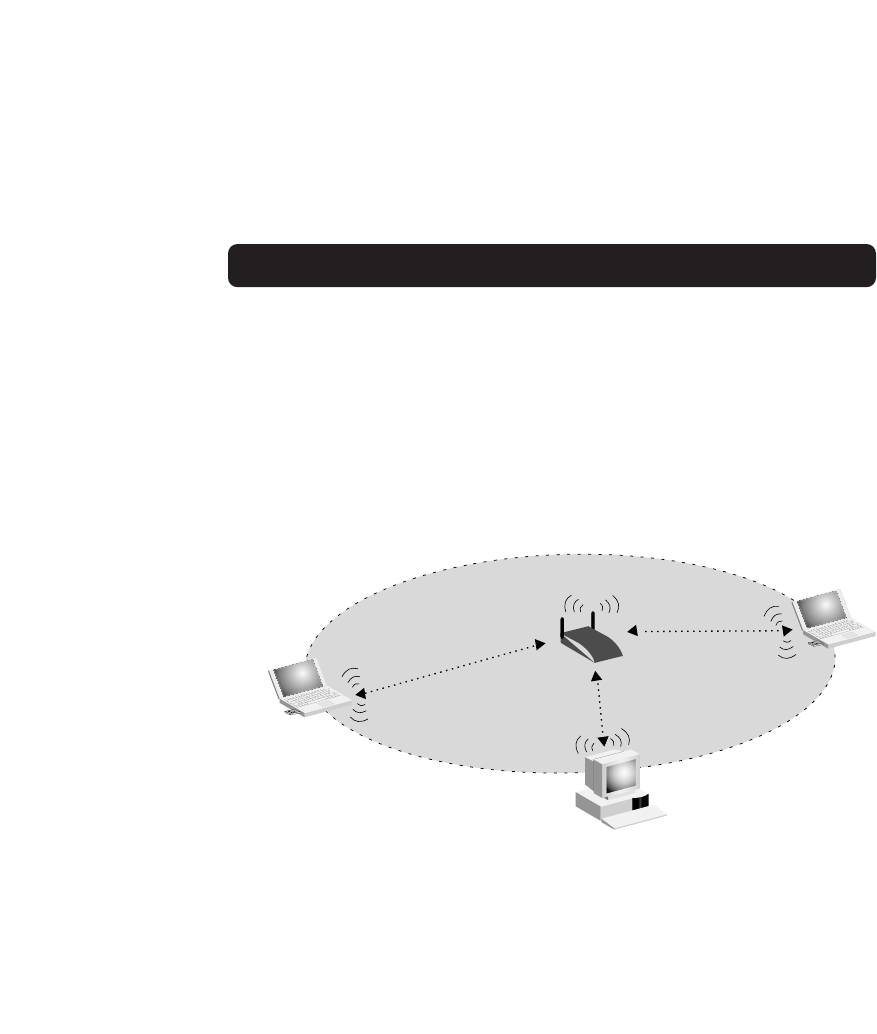
Installation
10
Using the WAP to expand local coverage
The WAP can act as a central point of communication of your
wireless-equipped computers without connecting it to a wired network. Using
the WAP in this manner will effectively double the range between your
wireless-equipped computers by relaying the data from one computer to
another. Simply locate the WAP in the center of the area you will be
operating your network. The diagram below illustrates this concept.
PC with Wireless Desktop
PCI Network Adapter
Wireless
Access Point
Notebook Wireless
Notebook Network Card
Notebook with Wireless
Notebook Network Card
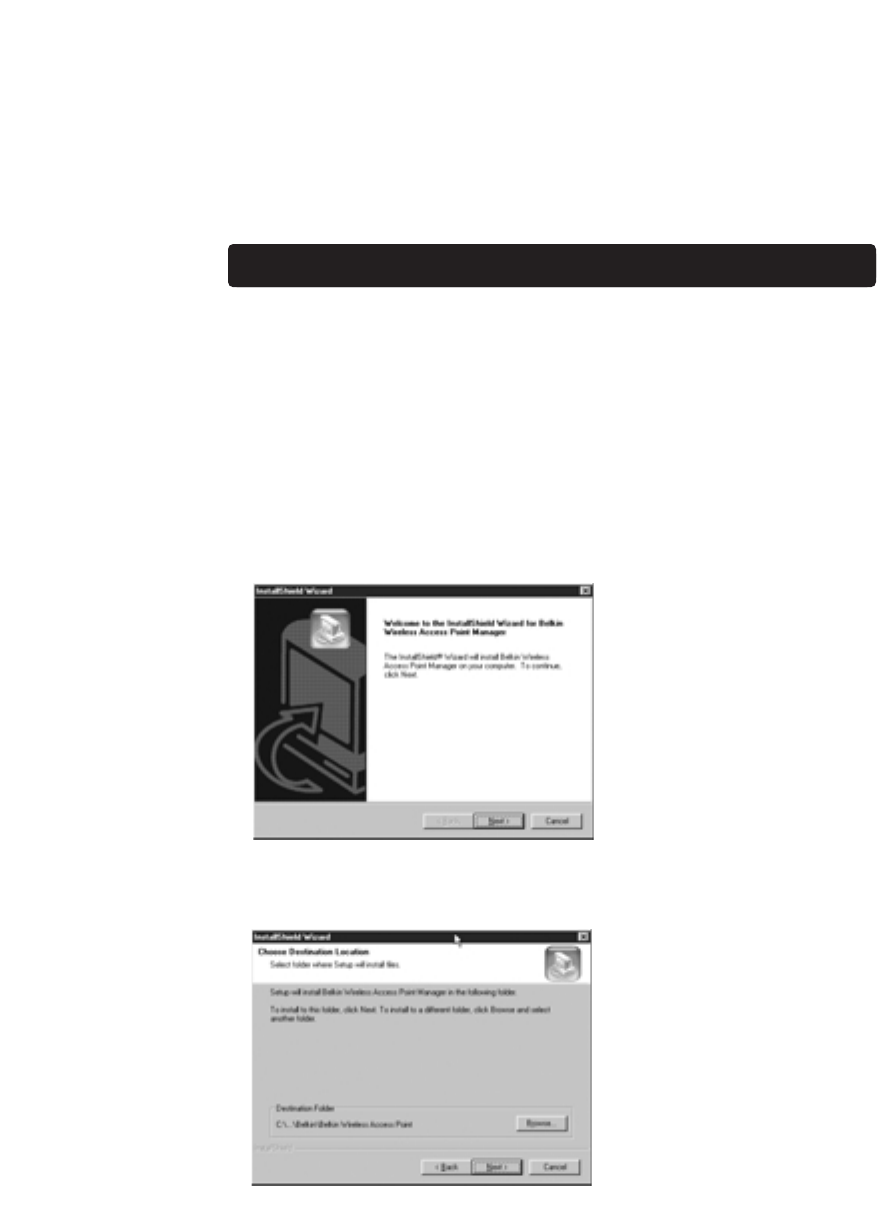
11
Installing the Wireless Access Point Manager Software
The Belkin 802.11b Wireless Manager Software allows you to connect to
the WAP and make changes to the configuration. Follow these steps to
install the software.
1. Insert the Belkin Wireless Network Access Point “CD-ROM” into your
CD-ROM drive.
2. Access your CD-ROM drive by double-clicking on the “CD-ROM” icon in
the “My Computer” window. Double-click on the “Setup” icon to start the
installation process.
3. The following screen will appear. Click "Next".
4. The installer will install the needed files to a folder named
"C:\Belkin\Belkin Wireless Access Point". If you wish to change this, click
"Browse" and select a folder. Click "Next" to continue.
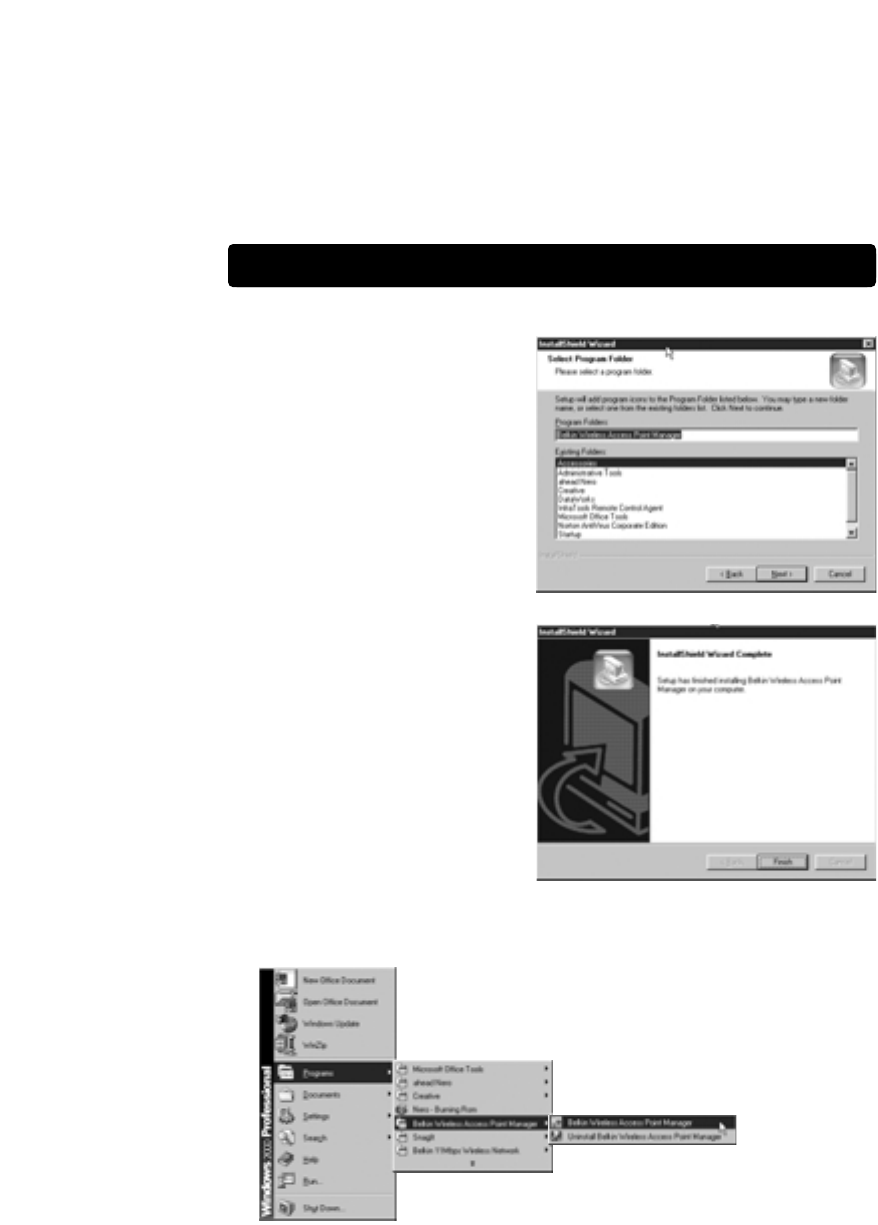
12
Installing the Wireless Access Point Manager Software
5. The installer will create a
program folder called "Belkin
Wireless Access Point
Manager". If you wish to
change this, enter a name or
select from the list below.
Click "Next" to continue.
6. Click "Finish" to complete
the installation.
Start the WAP Manager Software by clicking "Start", "Programs", then
select "Belkin Wireless Access Point Manager", then click on "Belkin
Wireless Access Point Manager".
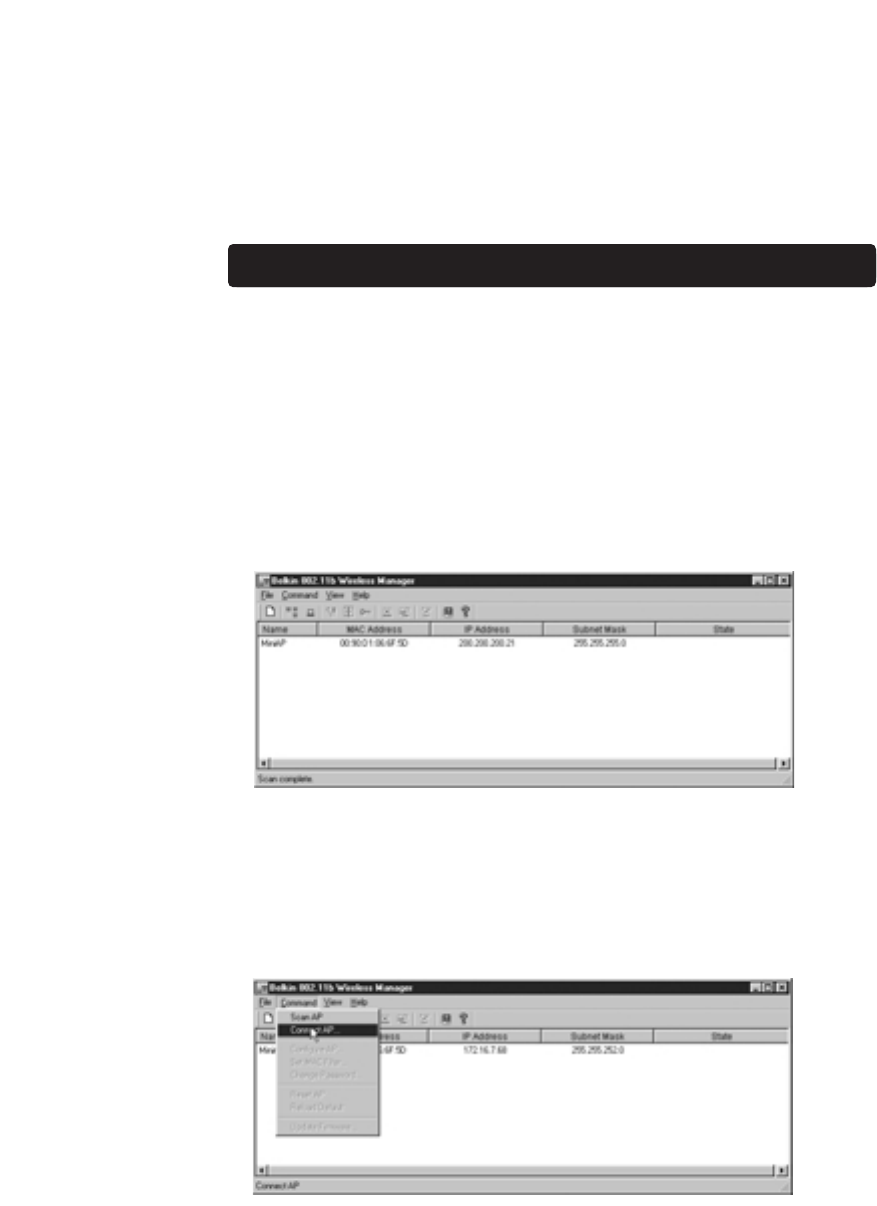
13
Using the Belkin Wireless Access Point Manager
Once you launch the WAP Manager Software, a window will open and begin
scanning for your WAP. The words "Scanning AP" will be displayed in the
bottom right corner of the window. When finished scanning, "Scanning
complete" will be displayed. You can connect to the WAP from any computer
on the network that is either wired or wireless. Your WAP is shipped from the
factory with the name "MiniAP". Instructions to change this are covered later in
this manual. If your WAP is installed properly, you should see the name
"MiniAP" in the “Wireless Manager” window when scanning has completed. If
not, see troubleshooting tips at the end of this manual.
Connecting to the WAP
To make any changes to the configuration of the WAP, you must connect to
the WAP by entering a password. The WAP is password-protected to keep
unauthorized users from changing settings.
1. Click on "Command" and select "Connect AP…" in the drop-down menu.
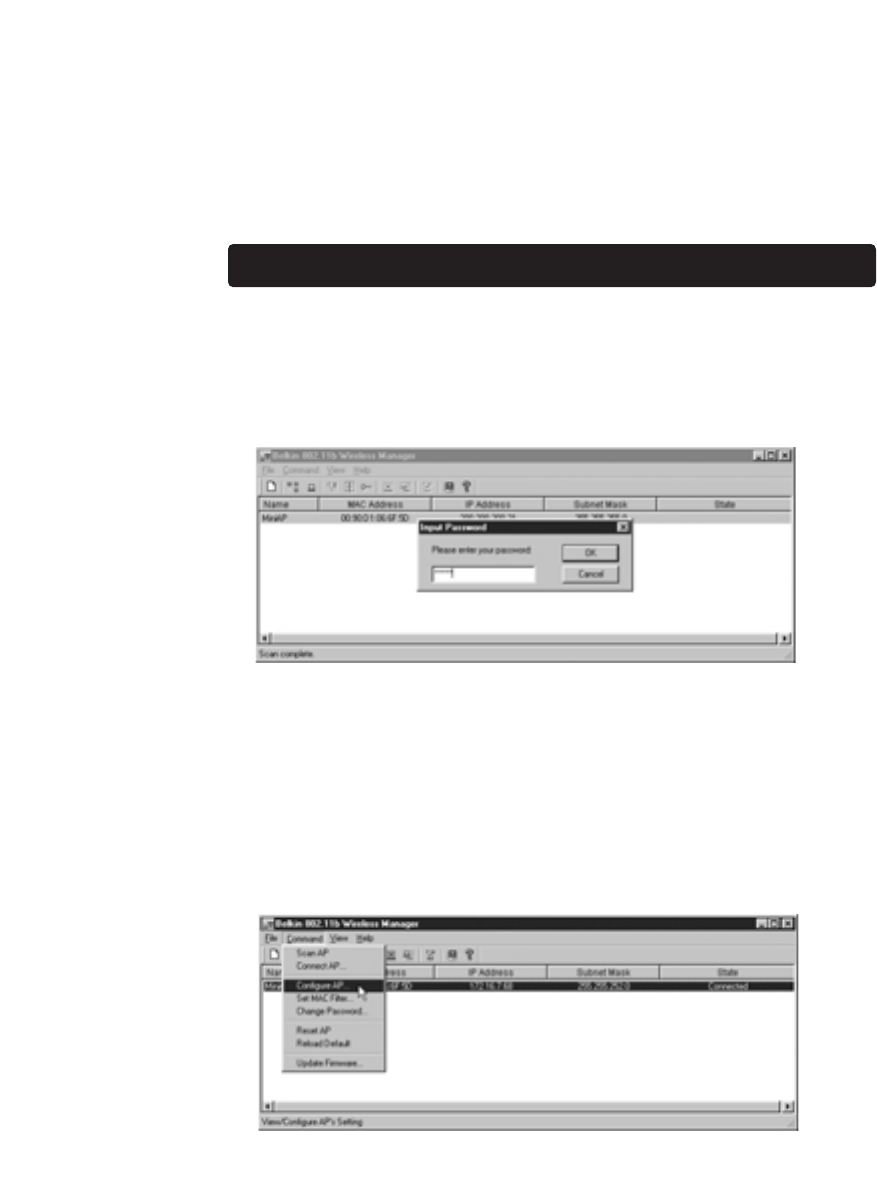
14
Using the Belkin Wireless Access Point Manager
2. The "Input Password" window will appear. Your WAP ships from the factory
with the password set to "MiniAP". Keep in mind that the password is case-
sensitive, and enter the password.
Password = "MiniAP" (case-sensitive)
3. When connected, the word "Connected" will appear under the column
labeled "State". If you cannot connect, see the troubleshooting tips at the
end of this manual.
Configuring to the WAP
The WAP can be configured for many different parameters—from setting the
password to enabling the encryption. To configure the WAP, click on
"Command" and select "Configure AP".
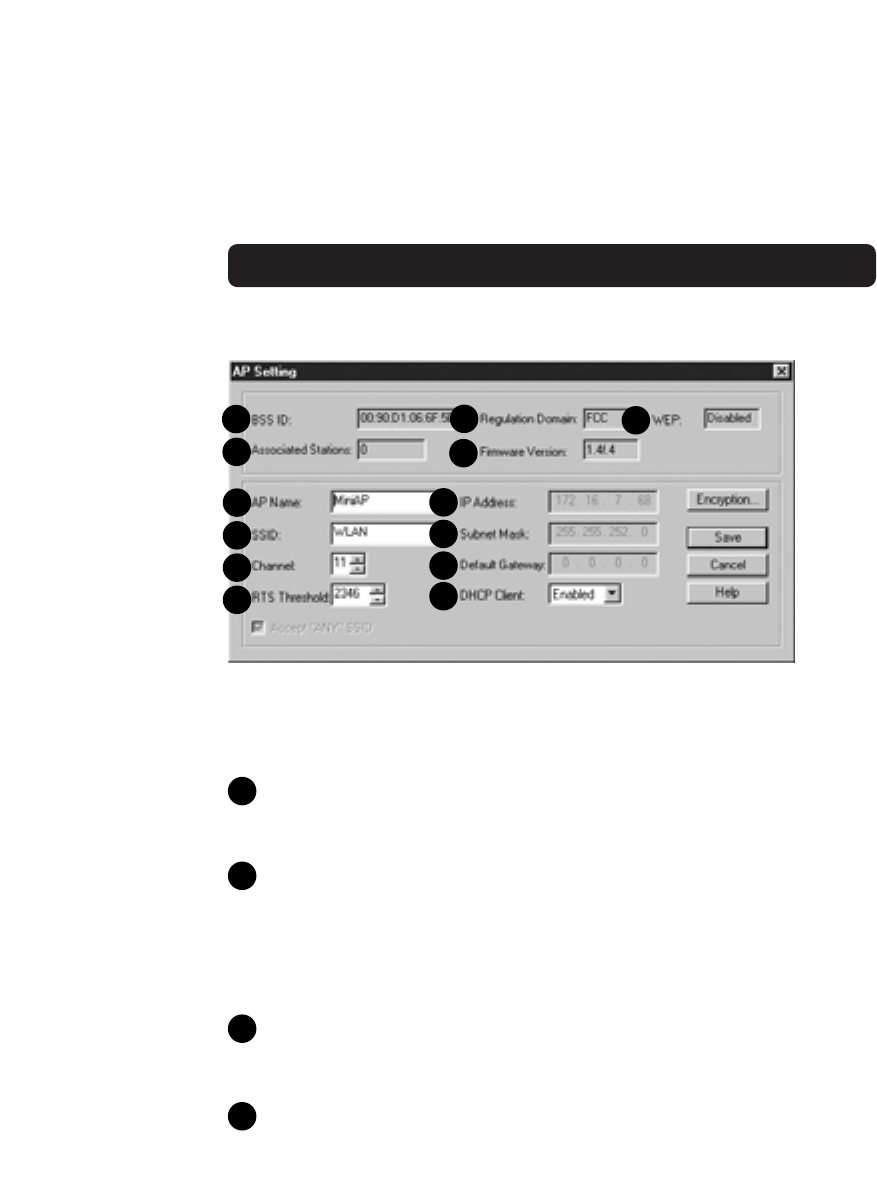
15
Using the Belkin Wireless Access Point Manager
The "AP Setting" screen will appear.
This screen displays the WAP’s status and settings.
Fixed Parameters
BSSID
This displays the MAC address of the adapter. The MAC address is fixed
and cannot be changed.
Regulation Domain
Each country’s regulatory commission (FCC for the US) has specified a
specific set of channels for 802.11b to operate on. Each country is
different. To comply with the standards for each country, the WAP is
programmed at the factory for the proper regulatory domain. The
regulatory domain is fixed and cannot be changed.
WEP
This displays the status of the WEP encryption. Disabled = OFF. Enabled =
ON.
Associated Stations
This indicates the number of wireless clients (computers) connected to the
WAP. A total of 64 wireless clients can be connected at a single time.
ABC
DE
FJ
G
H
I
K
L
M
A
B
C
D

16
Using the Belkin Wireless Access Point Manager
Firmware Version
Displays the version of firmware programmed into the WAP. Belkin may
from time to time upgrade the firmware and provide it, at no cost, for
download from the Belkin website. For more on upgrading the firmware,
visit www.networking.belkin.com/update.
Programmable Parameters
AP Name
The AP Name is used to help identify an WAP when multiple APs are
being used. For instance, in a large building using 20 APs, the names may
be "AP 1:WEST ROOM", or in a large house, "AP 5:Kitchen". To enter a
name, click in the name field and enter a name. When finished making
changes, click "Save" for the changes to take effect.
SSID
The Service Set Identifier (SSID) is like a name for the wireless network
and is sometimes called the "Network Name". All WAPs in a wireless
network should be set to the same SSID to enable clients to roam from
WAP to WAP. The wireless-equipped computers in the wireless network
should also be set to the same SSID to gain access to the network. The
default setting is "WLAN" (Wireless Local Area Network). To change the
SSID, simply click in the SSID field and enter a new SSID. When finished
making changes, click "Save" for the changes to take effect.
Channel
The 802.11b wireless standard supports up to 14 channels. The number of
available channels are limited to local regulations that determine which
channels are available. (FCC/IC: Channels 1-11; ETSI: Channels 1-13;
France: Channels 10-13; Spain: Channels 10-11; MKK: Channels 1-14.)
The default channel is 11. To change the channel, click the UP/DOWN
arrows next to the channel field. When finished making changes, click
"Save" for the changes to take effect.
RTS Threshold
This is the rate at which errors are checked. We recommend not
changing this.
E
F
G
H
I

Using the Belkin Wireless Access Point Manager
17
IP Address
An IP address can be manually entered. The default IP address is
192.168.0.254. To enter the IP address, click in the “IP Address” field and
enter the IP address.
Subnet Mask
A Subnet Mask can be manually entered. The default Subnet Mask is
255.255.255.0. To enter the Subnet Mask, click in the “Subnet Mask” field
and enter the Subnet Mask.
Default Gateway
A Default Gateway address can be manually entered. The Default
Gateway address is 0.0.0.0. To enter a Default Gateway address, click in
the “Subnet Mask” field and enter the Default Gateway address.
DHCP Client
The WAP can obtain an IP address, Subnet Mask, and Default Gateway
information automatically in a dynamic network environment. The default
setting is "Enabled". If the WAP is connected to a network that does not
employ DHCP, the default IP address, Subnet Mask, and Default Gateway
will be used. To enable or disable the DHCP Client, click on the down
arrow and select "Enabled" or "Disabled". When finished making changes,
click "Save" for the changes to take effect.
Security
The WAP features some methods of keeping your wireless network secure.
Using these methods can greatly increase your security and peace of mind.
Method 1: Encryption
For secure data transmissions, the Belkin WAP is capable of encrypting, or
"scrambling", the information that is sent over the air between your
computers. The WAP uses a form of encryption called WEP (Wired
Equivalent Privacy). There are two levels of WEP encryption—64-bit and
128-bit. As the numbers imply, 128-bit encryption is more secure than 64-
bit encryption. However, using 128-bit encryption can slow down the rate
at which data is sent between the wireless-equipped computers and the
WAP. WEP encryption uses keys to scramble and unscramble the data that
is being sent between wireless-equipped computers and the WAP. The
17
J
K
L
M

Using the Belkin Wireless Access Point Manager
18
WAP and the computers must use the same key to be able to communicate
using encryption. For more information, go to the section called “Using
WEP Encryption”.
Method 2: MAC Address Filtering
The WAP can be programmed with a list of MAC addresses that are
allowed to connect to the WAP. A MAC address is a unique "serial number"
that is assigned to every wireless adapter. For instance, if you own a Belkin
F5D6020 Wireless Notebook Network Adapter for your laptop, it has been
assigned its own MAC address at the factory. The MAC address is located
on a small sticker on the bottom of the product. Programming the WAP
with this MAC address and enabling the MAC address filtering feature lets
you manage which computers are allowed to connect to the WAP.
Using WEP Encryption
In the “Configuration” menu, click "Encryption". The following screen
will appear.
Select “64-bit” from the drop-down menu.
You will notice when using 64-bit
encryption, there are four keys labeled
"Key 1" through "Key 4". Only one key can
be used at a time. Keys can be entered
manually, but for ease-of-use, the software
can generate keys using a "passphrase" that
you enter. This passphrase can be easily
distributed to wireless-equipped computer
users in your network. For instance, creating
a key using the passphrase "Passphrase"
generates four keys in 64-bit encryption
mode and one key in 128-bit encryption mode. Users of laptops need only to
enter the passphrase and the key number into their computers’ wireless
management software to be able to communicate while using encryption. All
computers on the network must use the same encryption rate and passphrase.
The passphrase can be changed as often as desired.
18
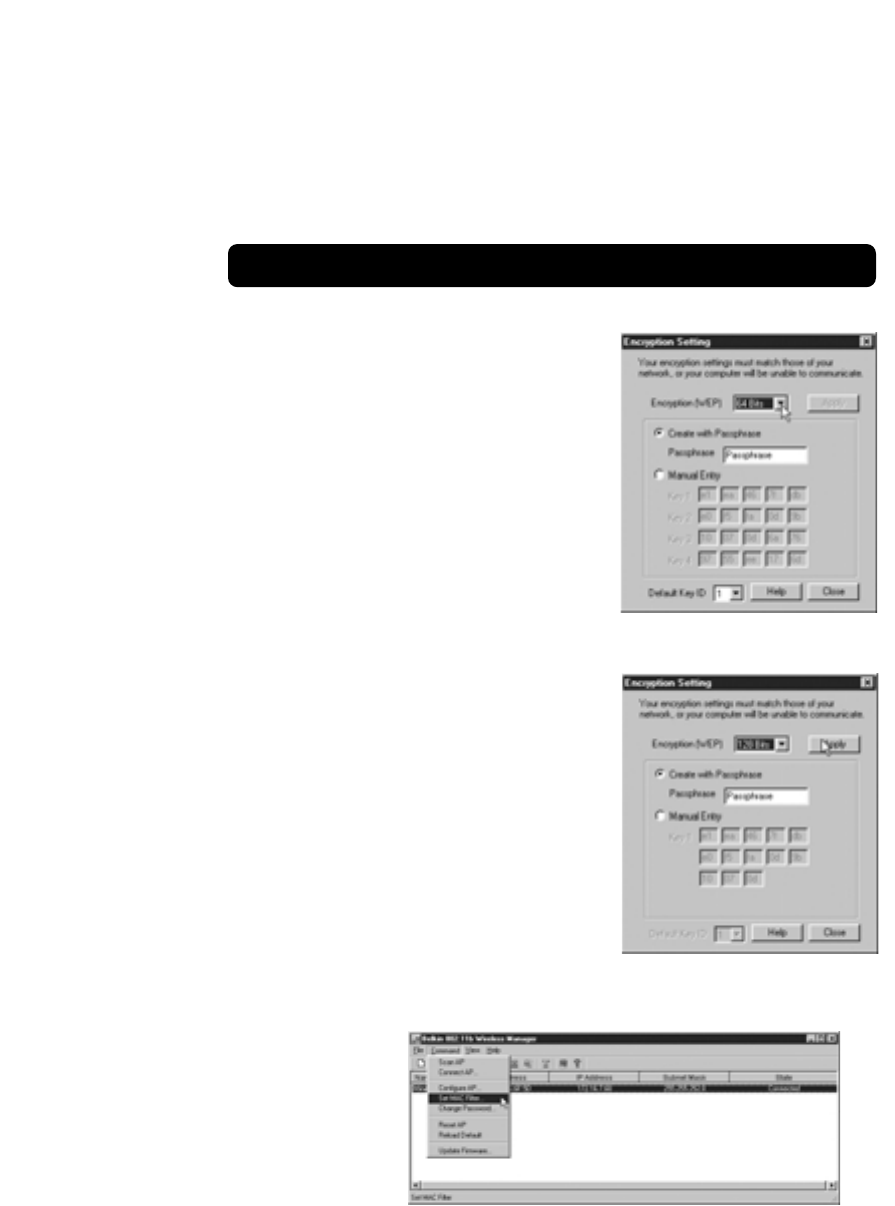
Using the Belkin Wireless Access Point Manager
Setting 64-bit Encryption
1. Select 64-bit from the drop-down menu.
2. Select "Create with Passphrase".
3. Enter a passphrase and click "Apply".
4. Select the "Default Key ID" from the
drop-down menu. These are labeled
1–4. Click "Apply".
64-bit encryption is now enabled in the
WAP. Each wireless-equipped computer
(client) that needs to communicate with the
WAP must be set to the same encryption settings.
Setting 128-bit Encryption
1. Select 128-bit from the drop-down menu.
2. Select "Create with Passphrase".
3. Enter a passphrase and click "Apply".
128-bit encryption is now enabled in the
WAP. Each wireless-equipped computer
(client) that needs to communicate with
the WAP must be set to the same
encryption settings.
Using MAC Address Filtering
1. To set up the MAC filtering, click on "Command" and select
"Set MAC Filter".
19
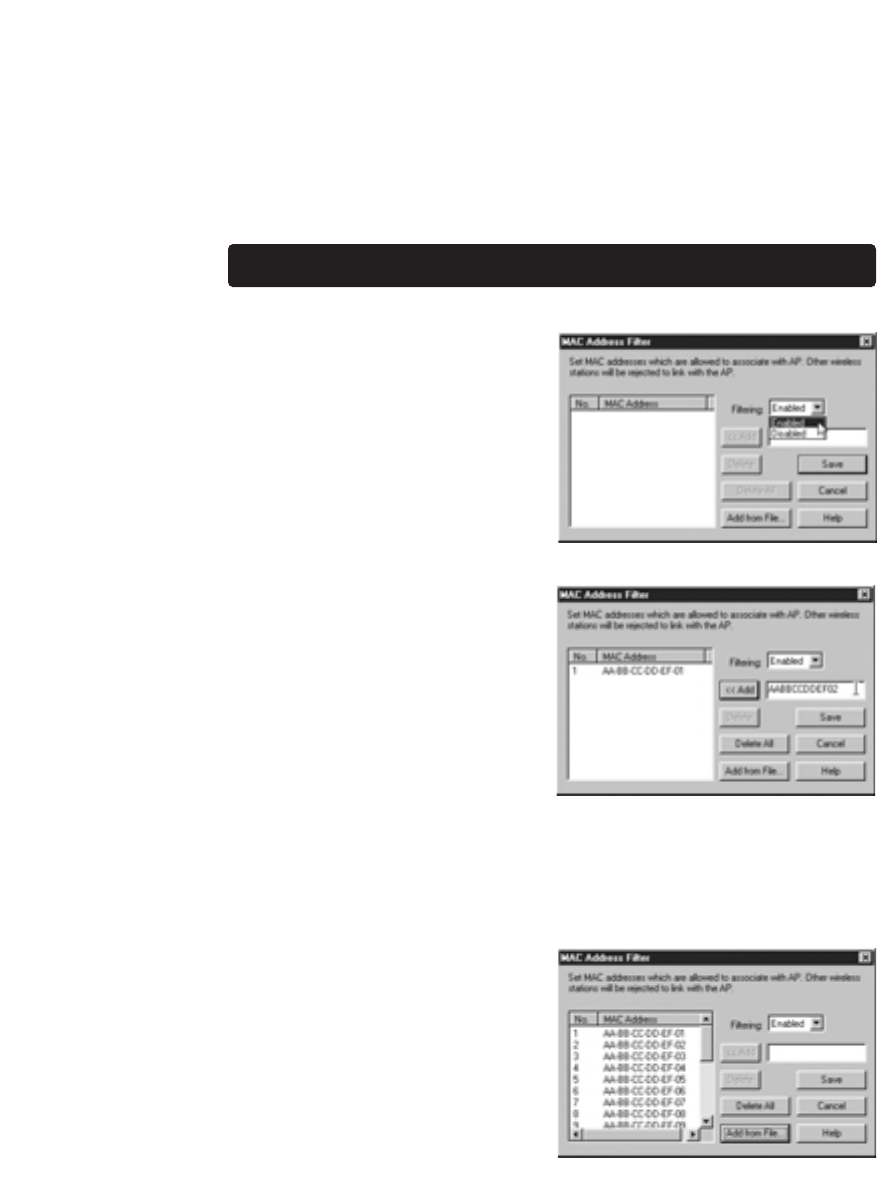
20
Using the Belkin Wireless Access Point Manager
2. The “MAC Address Filter”
screen will appear. The WAP
comes from the factory with the
MAC Address Filter disabled. To
enable the filtering, select
“Enabled” from the
drop-down menu.
3. In the field next to "<<Add",
type in the MAC address of
the adapter you want to add
to the list. Click "<<Add".
A total of 20 addresses can be entered into the WAP. To continue adding
addresses, repeat Step 3 until finished. Click "Save" when finished. It is
also possible to load a list of MAC addresses from a text file (.txt).
Adding a List of MAC Addresses from a File
1. Click "Add from File".
2. Select a .txt file from the browsing
window and click "Open".
3. The list of addresses will appear
in the “MAC Address” window.
4. Click "Save".

21
Using the Belkin Wireless Access Point Manager
Changing the Password
1. Select "Configure", then
"Change Password".
2. Enter the new password, then
confirm it. Press "OK".
After changing the password, you will need to connect to the AP again.
Resetting the WAP
If the WAP stops working properly, performing a reset can solve the problem.
From the main screen, select "Configure", then "Reset AP". The AP will reset
itself. After resetting, you will need to connect to the AP again.
Restoring Factory Default Settings
To restore the factory default settings, select "Configure", then "Reload Default".
The AP default settings will be restored. After restoring the defaults, you will
need to connect to the AP again.
WAP Parameter Default Value
AP Name MiniAP
SSID WLAN
Channel 11
RTS Threshold 2346
IP Address 192.168.0.254
Subnet Mask 255.255.255.0
Default Gateway 0.0.0.0
DHCP Client Enabled
Encryption Disabled
MAC Address Filter Disabled
Password MiniAP (case-sensitive)

22
Wireless Networking Using 802.11b
To form a wireless network, two basic components are used. The first is a
wireless adapter for a PC. This can be either a USB wireless adapter or a
PCMCIA adapter. The adapter gives the PC wireless Ethernet capabilities. The
second is a WAP. A WAP can connect to a wired LAN and allow the wireless
PCs to be able to access the wired LAN. A WAP can be a standalone
component or it can be embedded into a cable/DSL router, thus forming a
wireless Gateway/Router. The uses of each of these types of products is
outlined later in this article.
Wireless networking is not very different from wired networking. There are only
a few basic concepts one must grasp. There are two different ways to network
computers using 802.11b. The first, and least used method, is the Ad-Hoc
method, also known as Peer-to-Peer. The more commonly used method is
called Infrastructure.
Ad-Hoc (Peer-to-Peer)
Ad-Hoc, or Peer-to-Peer, refers to a configuration where each computer in
the wireless network communicates directly with another. An Ad-Hoc
wireless LAN consists of a group of computers, each equipped with a
wireless adapter, connected directly via radio signals to form an
independent wireless LAN. Computers in a specific Ad-Hoc wireless LAN
must be configured to the same radio channel to communicate with one
another. More than one Ad-Hoc network can exist in the same space if it is
configured to operate on a different channel. There are a varying number of
channels depending on the part of the world you are operating in. The US
has 11 channels, Europe has 13 channels, and Japan has 14 channels. The
following diagram shows a typical Ad-Hoc wireless LAN configuration.
Notebook with Wireless
Notebook Network Card
Notebook Wireless
Notebook Network Card
PC with Wireless Desktop PCI
Network Adapter
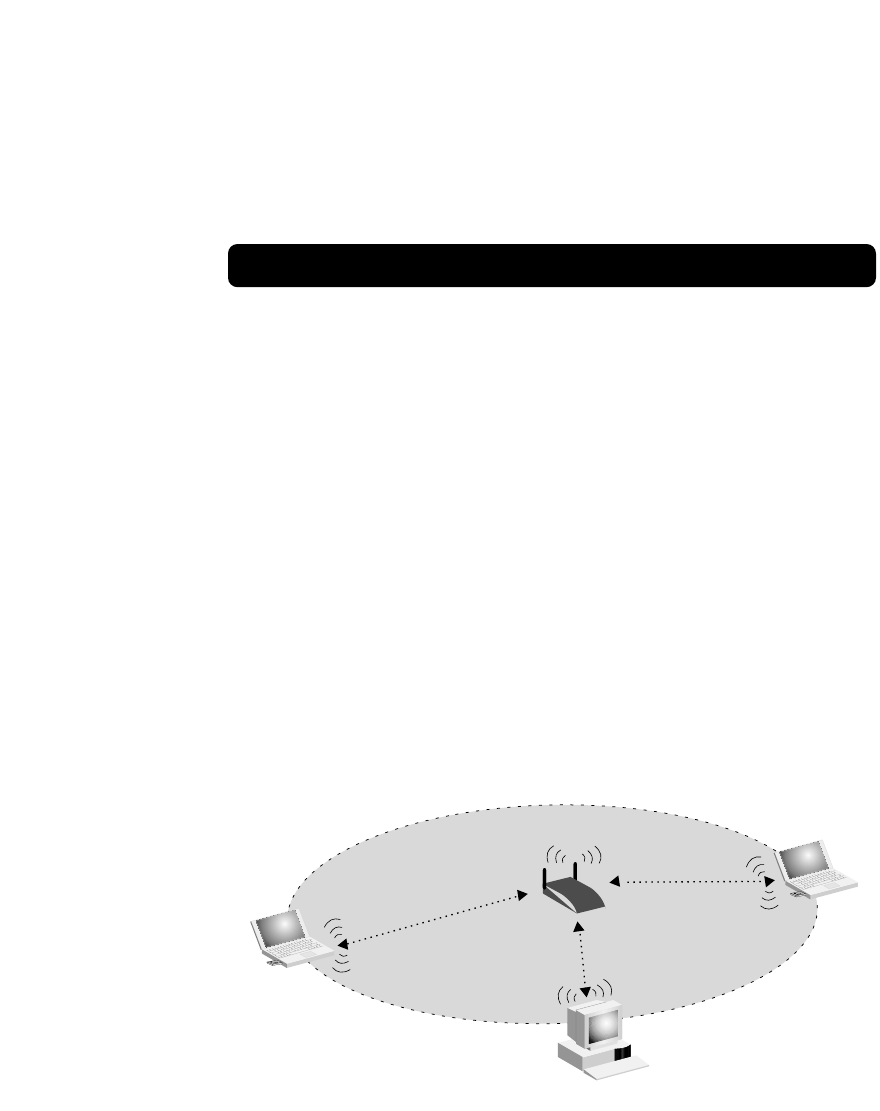
PC with Wireless Desktop
PCI Network Adapter
WAP
Notebook with Wireless
Notebook Network Card
Notebook Wireless
Notebook Network Card
23
Wireless Networking Using 802.11b
Infrastructure Mode
The use of a WAP to connect a wireless LAN to a wired LAN is called
Infrastructure. A WAP serves as a bridge between the wired and wireless
network. Connecting the WAP to any port on the wired network will give
wireless access to all wireless-equipped computers within its coverage area.
A WAP is configured with a Service Set Identifier. This is a "name" that is
given to the wireless network and is used by the wireless-equipped
computers to access the wireless network. WAPs can also be configured to
use encryption or grant access to computers with specific MAC addresses. A
WAP also effectively doubles the distance that computers in the wireless
LAN can be located from one another. This is because the WAP serves as a
central point for routing of all the wireless network traffic between the
wireless computers. Wireless-equipped computers networked together in
Infrastructure mode form a group called a Basic Service Set (BSS). Up to 64
individual computers can exist at a single time in a BSS. This is due to the
ability of the WAP to handle no more than 64 clients. The diagram below
illustrates how the WAP will effectively double the distance between
wireless-equipped computers in a BSS.
Basic Service
Set (BSS)
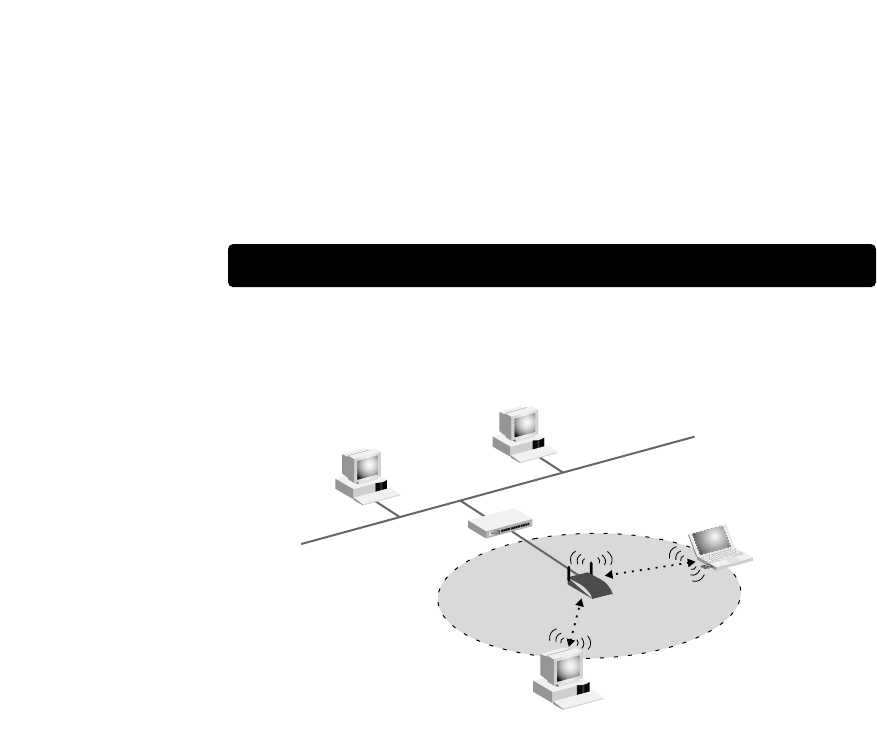
24
Wireless Networking Using 802.11b
Basic Service
Set (BSS)
The diagram below illustrates how a WAP acts as a bridge between the
wireless BSS and the wired network.
Notebook with Wireless
Notebook Network Card
Desktop PC
Desktop PC
Switch
Wireless
Access Point
PC with Wireless Desktop
PCI Network Adapter
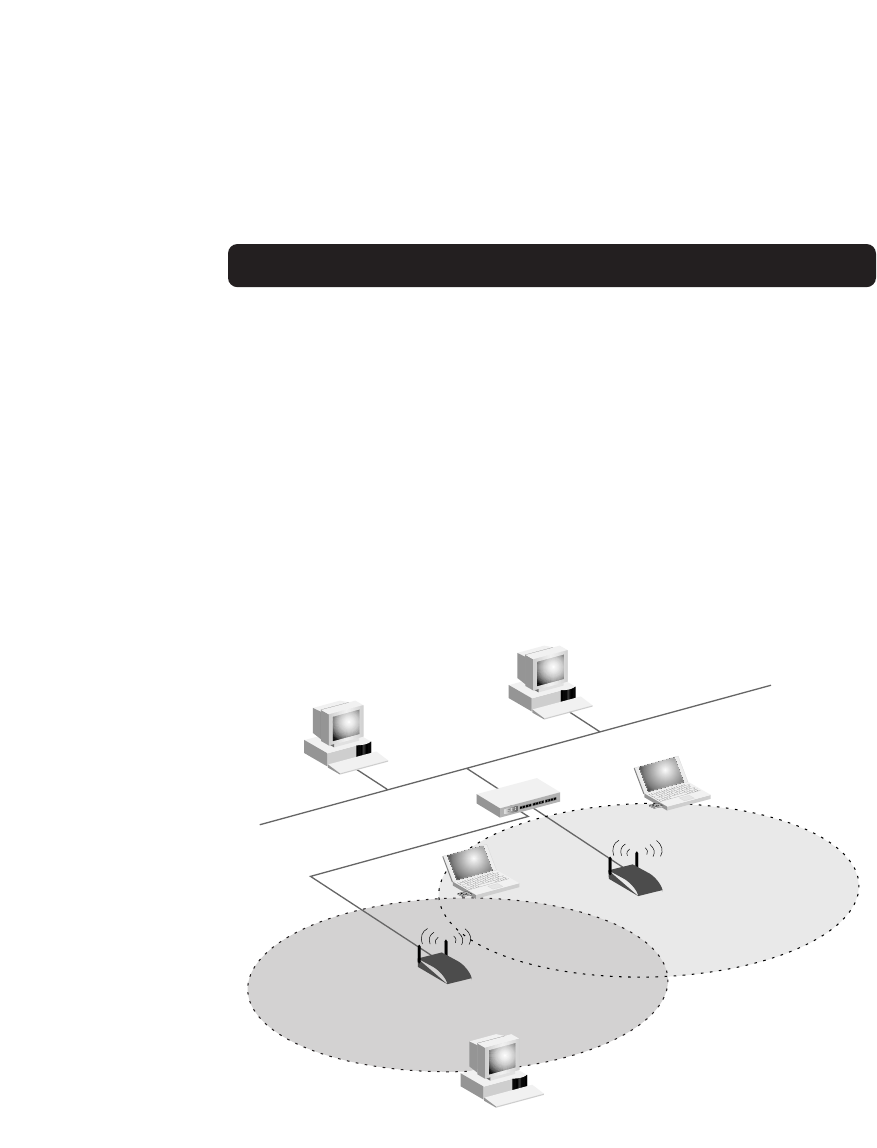
25
Wireless Networking Using 802.11b
Roaming
More than one WAP can be used to increase the wireless coverage in a
wireless LAN. The diagram below shows two WAPs configured to extend
coverage beyond that of a single WAP. The overlapping area of each BSS is
called an Extended Service Set (ESS). When a wireless computer enters the
ESS, the signal strength and link quality is evaluated by the computer and
the computer chooses the WAP with the best quality signal and link. This
activity is known as roaming. To configure WAPs to allow roaming inside of
the wireless network, each WAP will be assigned the same Service Set
Identifier (SSID). Strategically placing multiple WAPs around an office or
inside of the home can extend the wireless coverage to the entire premise.
The illustration below shows two Basic Service Sets overlapping to form an
Extended Service Set.
ESS
BSS2
BSS1
Desktop PC
Desktop PC Switch
Wireless
Access Point
Wireless
Access Point
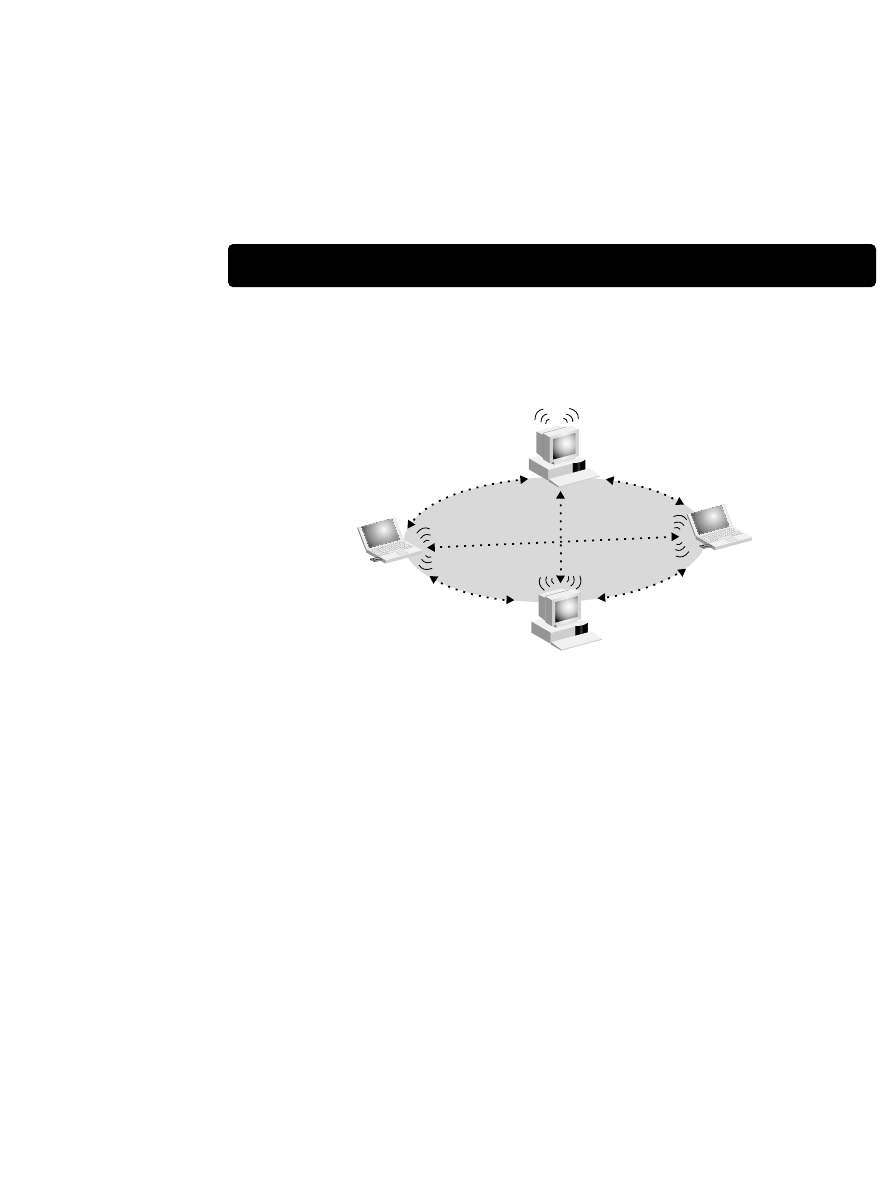
Ad-Hoc An Ad-Hoc wireless LAN is a group of computers each with
LAN adapters, connected as an independent wireless LAN.
Backbone The core infrastructure of a network. The portion of the
network that transports information from one central
location to another central location where it is unloaded
onto a local system.
Base Station In mobile telecommunications, a base station is the central
radio transmitter/receiver that maintains communications
with the mobile radiotelephone sets within its range. In
cellular and personal communications applications, each cell
or micro-cell has its own base station; each base station in
turn is interconnected with other cells or bases.
BSS BSS stands for Basic Service Set. A Basic Service Set is
comprised of a WAP and all the LAN PCs that are associated
with it.
ESS ESS (ESS-ID, SSID) stands for Extended Service Set. More than
one BSS is configured to become an Extended Service Set.
LAN mobile users can roam between different BSSes in an
ESS (ESS-ID, SSID).
Ethernet A popular local area data communications network, which
accepts transmission from computers and terminals. Ethernet
operates on a 10 or 100Mbps base band transmission rate,
using an unshielded, twisted-pair cable.
Notebook with Wireless
Notebook Network Card
Notebook Wireless
Notebook Network Card
PC with Wireless Desktop
PCI Network Adapter
26
Glossary of Wireless Networking Terms
Ad-Hoc Mode
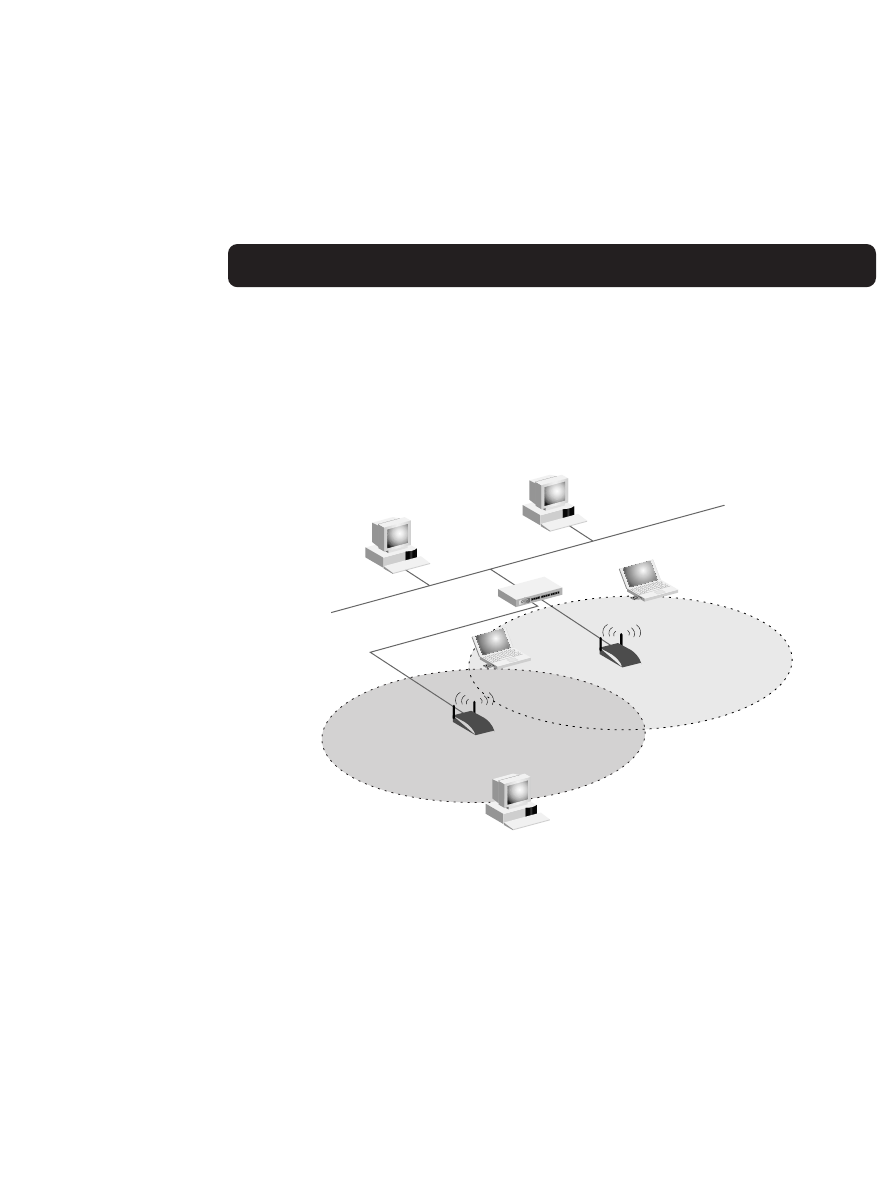
27
Glossary of Wireless Networking Terms
Infrastructure An integrated wireless and wired LAN is called an
Infrastructure configuration.
Roaming A wireless LAN mobile user moves around an ESS
and maintains a continuous connection to the
Infrastructure network.
RTS Threshold Transmitters contending for the medium may not be
aware of each other. RTS/CTS mechanisms can solve this
"Hidden Node Problem". If the packet size is smaller than
the preset RTS Threshold size, the RTS/CTS mechanism
will not be enabled.
WEP Wired Equivalent Privacy is based on the use of 64-bit or
28-bit keys and the popular RC4 encryption algorithm.
Wireless devices without a valid WEP key will be
excluded from network traffic.
Wireless Access
Point (WAP) An internetworking device that seamlessly connects
wired and wireless networks.
ESS
BSS2
BSS1
Desktop PC
Desktop PC Switch
Wireless
Access Point
Notebook with
Wireless PC Card
Wireless
Access Point
PC with Wireless
PCI Adapter
Notebook with
Wireless PC Card
Infrastructure Mode,
BSS, and ESS

28
Glossary of Wired Networking Terms
DHCP Dynamic Host Configuration Protocol. This protocol
automatically configures the TCP/IP settings of every
computer on your home network.
DNS Server
Address DNS stands for Domain Name System, which allows Internet
host computers to have a domain name (such as belkin.com)
and one or more IP addresses (such as 192.34.45.8). A DNS
server keeps a database of host computers and their
respective domain names and IP addresses, so that when a
domain name is requested (as in typing "belkin.com" into
your Internet browser), the user is sent to the proper IP
address. The DNS server address used by the computer on
your home network is the location of the DNS server your
ISP has assigned.
DSL Modem DSL stands for Digital Subscriber Line. A DSL modem uses
your existing phone lines to transmit data at high speeds.
Ethernet A standard for computer networks. Ethernet networks are
connected by special cables and switches, and move data
around 100Mbps.
IP Address IP stands for Internet Protocol. An IP address consists of a
series of four numbers, separated by periods, that identify a
single, unique Internet computer host. Example: 192.34.45.8.
ISP Internet Service Provider. An ISP is a business that provides
connectivity to the Internet for individuals and other
businesses or organizations.
ISP Gateway
Address (see ISP for definition). The ISP Gateway Address is an IP
address for the Internet router located at the ISP's office. This
address is required only when using a cable or DSL modem.
LAN Local Area Network. A LAN is a group of computers and
devices connected together in a relatively small area (such
as a house or an office). Your home network is considered
a LAN.
MAC Address MAC stands for Media Access Control. A MAC address is the

29
Glossary of Wired Networking Terms
hardware address of a device connected to a network. A
MAC address is unique (different) for every device.
NAT Network Address Translation. This process allows all of the
computers on your home network to use one IP address.
Using the NAT capability of the Belkin 4-Port Cable/DSL
Gateway Router, you can access the Internet from any
computer on your home network without having to purchase
more IP addresses from your ISP.
PPPoE Point-to-Point Protocol over Ethernet. Point-to-Point Protocol
is a method of secure data transmission originally created for
dial-up connections; PPPoE is for Ethernet connections.
SPI Stateful Packet Inspection. SPI is the type of corporate-grade
Internet security provided by your Belkin 4-Port Cable/DSL
Gateway Router. Using SPI, the gateway acts as a "firewall,"
protecting your network from computer hackers.
Subnet Mask A subnet mask, which may be a part of the TCP/IP
information provided by your ISP, is a set of four numbers
configured like an IP address. It is used to create IP address
numbers used only within a particular network (as opposed
to valid IP address numbers recognized by the Internet,
which must be assigned by InterNIC).
TCP/IP Transmission Control Protocol/Internet Protocol. This is the
standard protocol for data transmission over the Internet.
WAN Wide Area Network. A network that connects computers
located in geographically separate areas (i.e., different
buildings, cities, countries). The Internet is a wide area
network.

30
Troubleshooting
Cannot connect to the WAP
using the Wireless Access
Point Manager Utility.
-OR-
I forgot my password.
The default password is "MiniAP". It is
case-sensitive. Make sure that you are
capitalizing where necessary. If you have
forgotten the password, see below for
performing a reset.
Perform a manual reset. To do so,
disconnect the power adapter. Use a
thin metal object, such as a paper clip,
to press and hold the button on the
bottom of the AP. While keeping the
button held down, reconnect the power
adapter. Wait for about five seconds for
the AP to restart.
Note: Performing a reset will restore the
factory default settings. All of your
settings will be lost.
The range is poor. See “Selecting an Appropriate Site for
your Wireless Access Point” in the
“Installation” section of this manual.
Solution
Make sure that each wireless client is
configured to the same encryption setting.
Make sure that each wireless client is
configured to connect to the SSID of the
WAP.
Problem
Wireless users (clients) do not
have access to the network
through the WAP.

31
Information
FCC Statement
DECLARATION OF CONFORMITY WITH FCC RULES FOR
ELECTROMAGNETIC COMPATIBILITY
We, Belkin Components, of 501 West Walnut Street, Compton, CA 90220, declare under
our sole responsibility that the product, F5D6130
to which this declaration relates,
complies with Part 15 of the FCC Rules. Operation is subject to the following two conditions: (1)
this device may not cause harmful interference, and (2) this device must accept any interference
received, including interference that may cause undesired operation.
Caution: Exposure to Radio Frequency Radiation.
The radiated output power of this device is far below the FCC radio frequency exposure lim-
its. Nevertheless, the device shall be used in such manner that the potential for human con-
tact normal operation is minimized.
When connecting an external antenna to the device, the antenna shall be placed in such a
manner to minimize the potential for human contact during normal operation. In order to
avoid the possibility of exceeding the FCC radio frequency exposure limits, human proximity
to the antenna shall not be less than 20cm (8inches) during normal operation.
Federal Communications Commission Notice
This equipment has been tested and found to comply with the limits for a Class B digital
device, pursuant to Part 15 of the FCC Rules. These limits are designed to provide reason-
able protection against harmful interference in a residential installation.
This equipment generates, uses, and can radiate radio frequency energy. If not installed and
used in accordance with the instructions, it may cause harmful interference to radio or tele-
vision reception, which can be determined by turning the equipment off and on, the user is
encouraged to try and correct the interference by one or more of the following measures:
• Reorient or relocate the receiving antenna.
• Increase the distance between the equipment and the receiver.
• Connect the equipment to an outlet on a circuit different from that to which the receiver is
connected.
• Consult the dealer or an experienced radio/TV technician for help.
Modifications
The FCC requires the user to be notified that any changes or modifications to this device that
are not expressly approved by Belkin Components may void the users authority to operate
the equipment.

Canada- Industry Canada (IC)
The wireless radio of this device complies with RSS 139 & RSS 210 Industry Canada. This
Class B digital complies with Canadian ICES-003.
Cet appareil numérique de la classe B conforme á la norme NMB-003 du Canada.
Europe-European Union Notice
Radio products with the CE 0560 or CE alert marking comply
with the R&TTE Directive (1995/5/EC) issued by the Commission
of the European Community.
Compliance with this directive implies conformity to the following
European Norms (in brackets are the equivalent international
standards).
• EN 60950 (IEC60950) – Product Safety
• EN 300 328 Technical requirement for radio equipment
• ETS 300 826 General EMC requirements for radio equipment.
To determine the type of transmitter, check the identification label on your Belkin product.
Products with the CE marking comply with the EMC Directive (89/336/EEC)
and the Low Voltage Directive (72/23/EEC) issued by the Commission of the
European Community. Compliance with these directives implies conformity
to the following European Norms (in brackets are the equivalent international
standards).
• EN 55022 (CISPR 22) – Electromagnetic Interference
• EN 55024 (IEC61000-4-2,3,4,5,6,8,11)- Electromagnetic Immunity
• EN 61000-3-2 (IEC610000-3-2) - Power Line Harmonics
• EN 61000-3-3 (IEC610000) – Power Line Flicker
• EN 60950 (IEC60950) – Product Safety
Products that contain the radio transmitter are labeled with CE 0122 or CE alert marking and
may also carry the CE logo.
Information
32

Information
33
Belkin Components Limited Lifetime Product Warranty
Belkin Components warrants this product against defects in materials and workmanship for its lifetime.
If a defect is discovered, Belkin will, at its option, repair or replace the product at no charge provided it
is returned during the warranty period, with transportation charges prepaid, to the authorized Belkin
dealer from whom you purchased the product. Proof of purchase may be required.
This warranty does not apply if the product has been damaged by accident, abuse, misuse, or
misapplication; if the product has been modified without the written permission of Belkin; or if any
Belkin serial number has been removed or defaced.
THE WARRANTY AND REMEDIES SET FORTH ABOVE ARE EXCLUSIVE IN LIEU OF ALL OTHERS,
WHETHER ORAL OR WRITTEN, EXPRESSED OR IMPLIED. BELKIN SPECIFICALLY DISCLAIMS ANY AND
ALL IMPLIED WARRANTIES, INCLUDING, WITHOUT LIMITATION, WARRANTIES OF MERCHANTABILITY
AND FITNESS FOR A PARTICULAR PURPOSE.
No Belkin dealer, agent, or employee is authorized to make any modification, extension, or addition to
this warranty.
BELKIN IS NOT RESPONSIBLE FOR SPECIAL, INCIDENTAL, OR CONSEQUENTIAL DAMAGES
RESULTING FROM ANY BREACH OF WARRANTY, OR UNDER ANY OTHER LEGAL THEORY,
INCLUDING BUT NOT LIMITED TO, LOST PROFITS, DOWNTIME, GOODWILL, DAMAGE TO OR
REPROGRAMMING, OR REPRODUCING ANY PROGRAM OR DATA STORED IN, OR USED WITH,
BELKIN PRODUCTS.
Some states do not allow the exclusion or limitation of incidental or consequential damages or exclusions
of implied warranties, so the above limitations of exclusions may not apply to you. This warranty gives
you specific legal rights, and you may also have other rights that vary from state to state.

34

Belkin Components B.V.
Starparc Building • Boeing Avenue 333
1119 PH Schiphol-Rijk • The Netherlands
Tel: +31 (0) 20 654 7300
Fax: +31 (0) 20 654 7349
Belkin Components, Ltd.
Unit 13 • Gatelodge Close • Round Spinney
Northampton • Northants • NN3 8RX • United Kingdom
Tel: +44 (0) 1604678300
Fax: +44 (0) 1604678330
Belkin Components
501 West Walnut Street
Compton • CA • 90220 • USA
Tel: 310.898.1100
Fax: 310.898.1111
© 2001 Belkin Components. All rights reserved. All trade names are registered
trademarks of respective manufacturers listed.
Belkin Components, Ltd.
7 Bowen Cresent • West Gosford
NSW 2250 • Australia
Tel: +61 (2) 4372 8600
Fax: +61 (2) 4325 4277
P73829-A